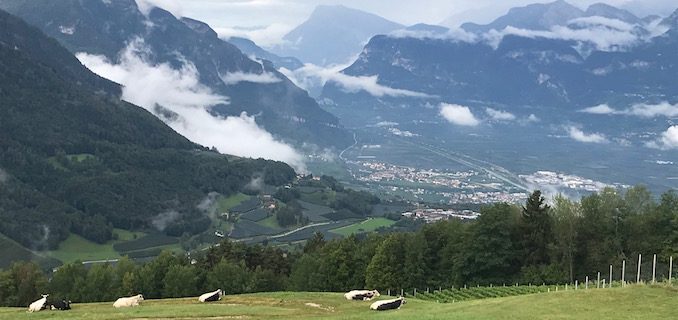
High on a mountain range in the far north-east of Italy, travel editor Winsor Dobbin discovers a wine region that also has plenty to offer walkers, hikers and bikers.
Done Tuscany? Discovered Piedmont? Why not sample one of Italy’s most idiosyncratic wine regions: the Alto Adige. Overlooked by the Dolomites, the Alto Adige is bordered by Austria and Germany and is also known by its German name of Sud Tyrol.
The scenery is spectacular, the wines excellent and the skiing stunning during winter (the famous winter resort of Val Gardena is just a short drive from the regional capital of Bolzano). In summer, alpine trekking is popular.
Your base for exploring the steep vineyards will almost certainly be the delightful city of Bolzano (known as Bozen in German).
The Parkhotel Laurin, in the heart of the small city, just a short stroll for the cathedral, is a delightful upmarket hotel with lovely gardens. Dining al a cartehere is a real pleasure. More affordable, but part of the same group and just around the corner is the Hotel Grief, with a rooftop garden on a side street just off the Piazza Walther.
This design hotel has different themes in each room and offers free wifi and a gym. The staff are excellent and the breakfasts big enough to set you up for a day of exploring the hillsides that are home to various grape varieties including pinot grigio, chardonnay, sauvignon blanc, pinot bianco, riesling, müller-thurgau, moscato, sylvaner and gewürztraminer as well as reds including lagrein, schiava, pinot noir and cabernet franc.
In just a short period of time, Alto Adige has become Italy’s top premium white wine region due to its Alpine-Mediterranean climate, the quality of the soils and the enviable locations of the vineyards.
The local food is a heady mix of Italian and German influences. Think dishes like spatzle:small gnocchi made with eggs, flour, and water, which can be eaten with a simple butter and chives condiment.
A traditional meal will often involve some type of cured meat, the most famous being speck, a dry-cured, lightly smoked ham, eaten sliced by itself or with rustic breads. There are also several local cheeses (you’ll see dairy cows on many of the hillsides) chief among them trentingrana. Desserts are often made with apples, pears or plums, as these fruits are widely cultivated in the region. The quality of food is generally high; you don’t necessarily have to go to a fancy restaurant – just stop at a local malga (mountain hut).
When it comes to wine, the Alto Adige is Italy’s version of Tasmania with the cool climate producing bright wines high in acidity. Like Tasmania, too, Alto Adige produces only one percent of all Italian wines, but has a reputation with many of its wines exported to Australia. Grapes have been grown here since early Roman times.
The peaks of the Dolomites, a UNESCO World Heritage site, rise to more than 3,000 metres and offer surprises whichever way you turn. Situated in north-eastern Italy, the name “Alto Adige” was created in the late 18th-century by the French occupier Napoleon Bonaparte, The region was annexed to Italy in 1919, after World War I, but the Austrian/German influences are dominant, not least its range of fragrant white wines and German-accented syllables.
During our recent stay, the centre of Bolzano was taken over by German bands for a massive beer festival that resembled a mini Oktoberfest. The province of Bolzano is dotted with picturesque small towns and is noteworthy for the fact that three cultures and languages live in harmony: Italian, German and the local Ladin dialect.
History and architecture buffs are drawn to the magnificent Benedictine Abbey of Monte Maria and the medieval Castel Coira on the rocky surface of the Venoste Alps.
For wine lovers, Cantina Terlano, a co-operative founded in 1893 in the village of Terlan, welcomes visitors and produces stellar white wines. It is worth a walk to take in terraced Vorberg vineyards. In the village of Magré, Alois Lageder’s Löwengang winery is a relative newcomer, built in 1995 to strict environmental and ecological criteria.
Both of these producer’s wines are available in Australia, along with Tieffenbrunner, Kurtatsch, Castelfeder, Peter Zemmer and several others.
THE FACTS
If you are already in Europe you can fly direct to Bolzano and hire a car. Alternatively, Emirates Airline flies to Munich, from where you can catch a train or shuttle bus to Bolzano. Innsbruck is another nearby local airport.
For more details visit www.suedtirol.infoor www.altoadigewines.com.
# The writer was a guest of the Alto Adige Wine Summit and was assisted by Eurail, which offers a range of travel passes.

Eurail Passes allow you travel through Europe (country to county and within regions) via train. Not only is it a quick and easy alternative travelling method (no checking in, waiting for security) it is an amazing and picturesque way to travel and see what Europe has to offer, as it allows you to gaze out the window and take in those beautiful landscapes.
Launched in 1959, the Eurail pass gives travellers of all ages the ability to visit up to 31 different European countries.
Even travellers visiting Europe on short itineraries can benefit from the ease and cost effectiveness of a Eurail Pass, with options starting from three days and extending to itineraries of up to three months.
There is an excellent phone app available that works offline and features rail schedules across the network, including notification of any trains that may require reservations or supplements.
I found trains a delightful way to travel. See www.eurail.com/en
Words: Winsor Dobbin
